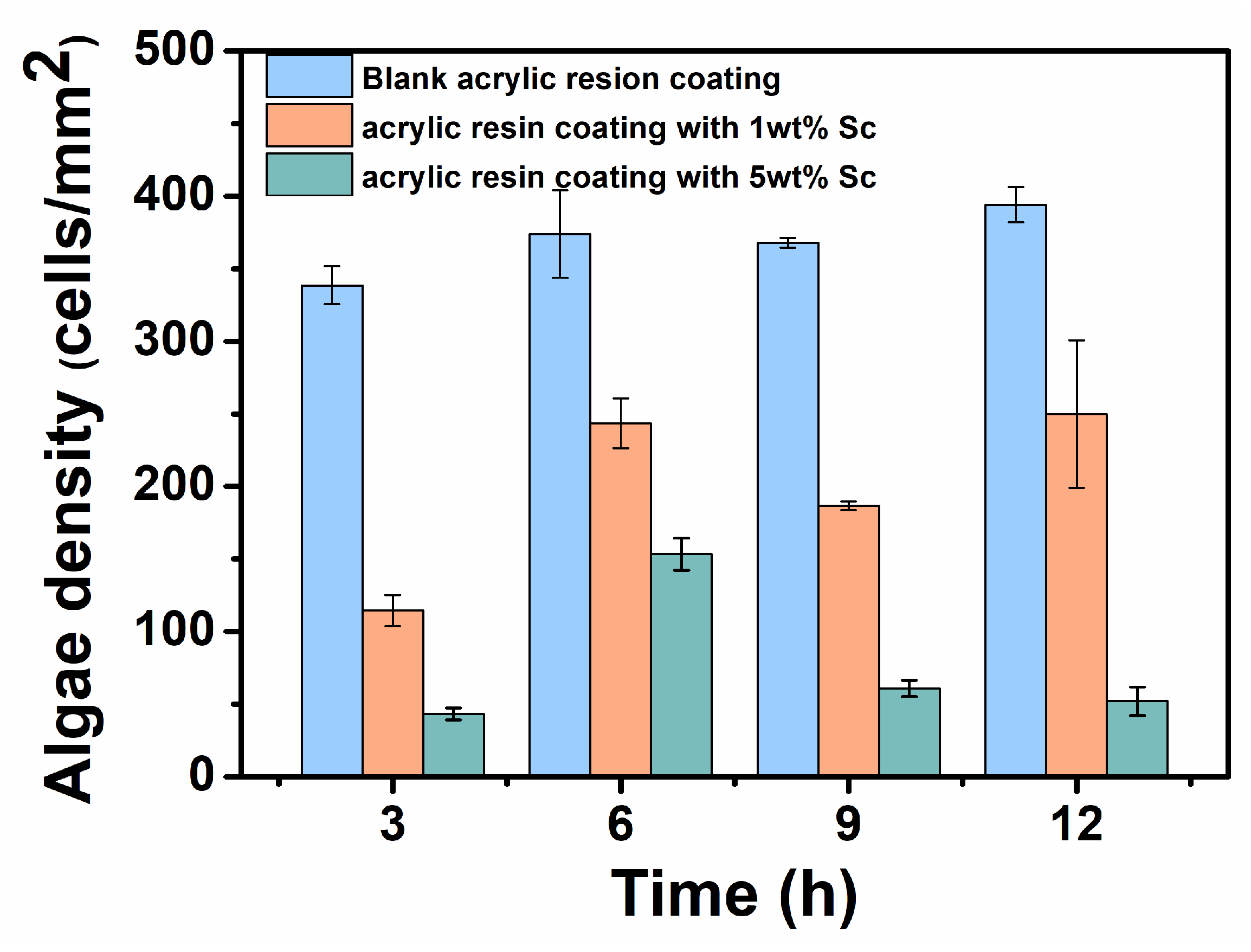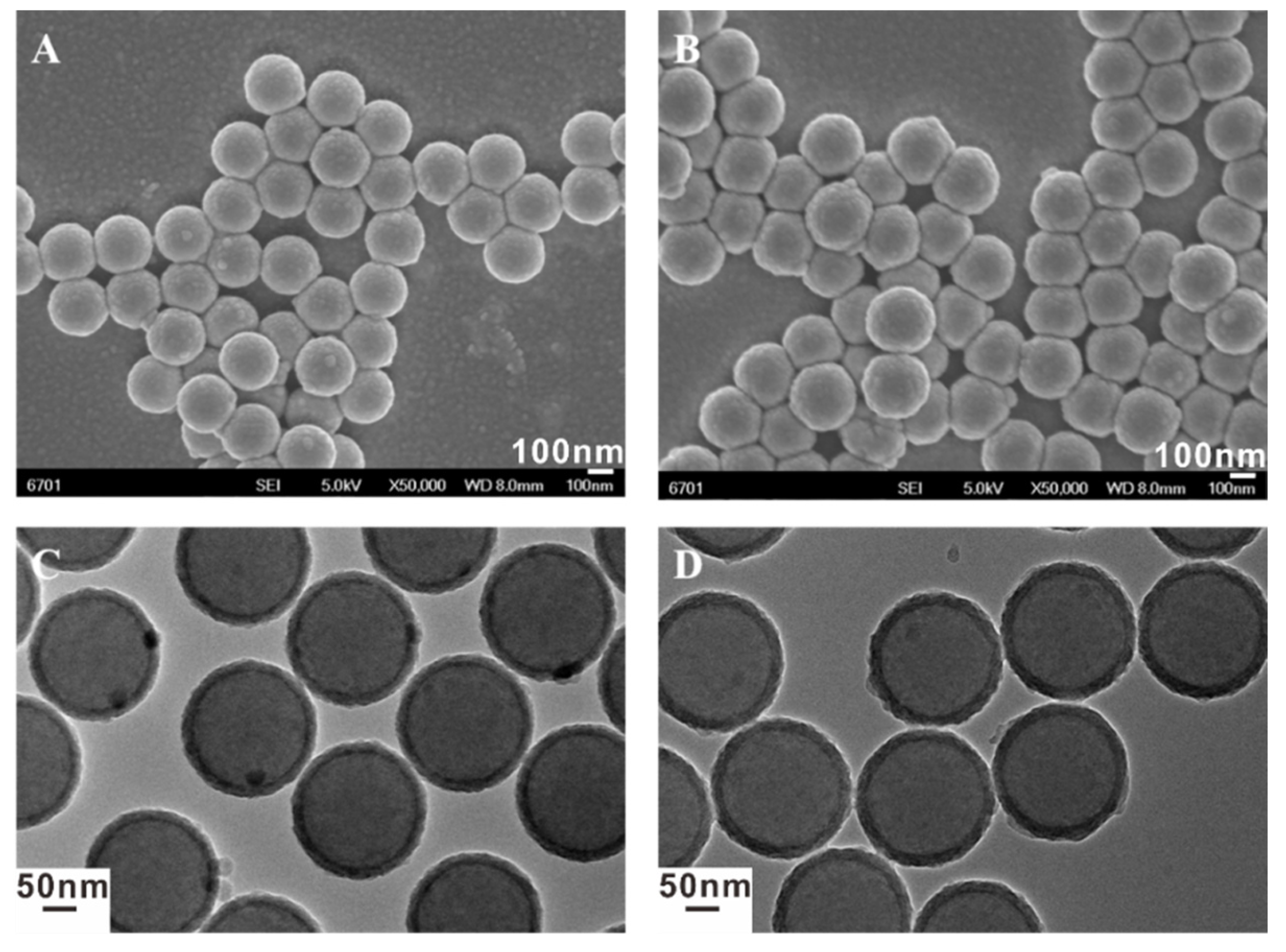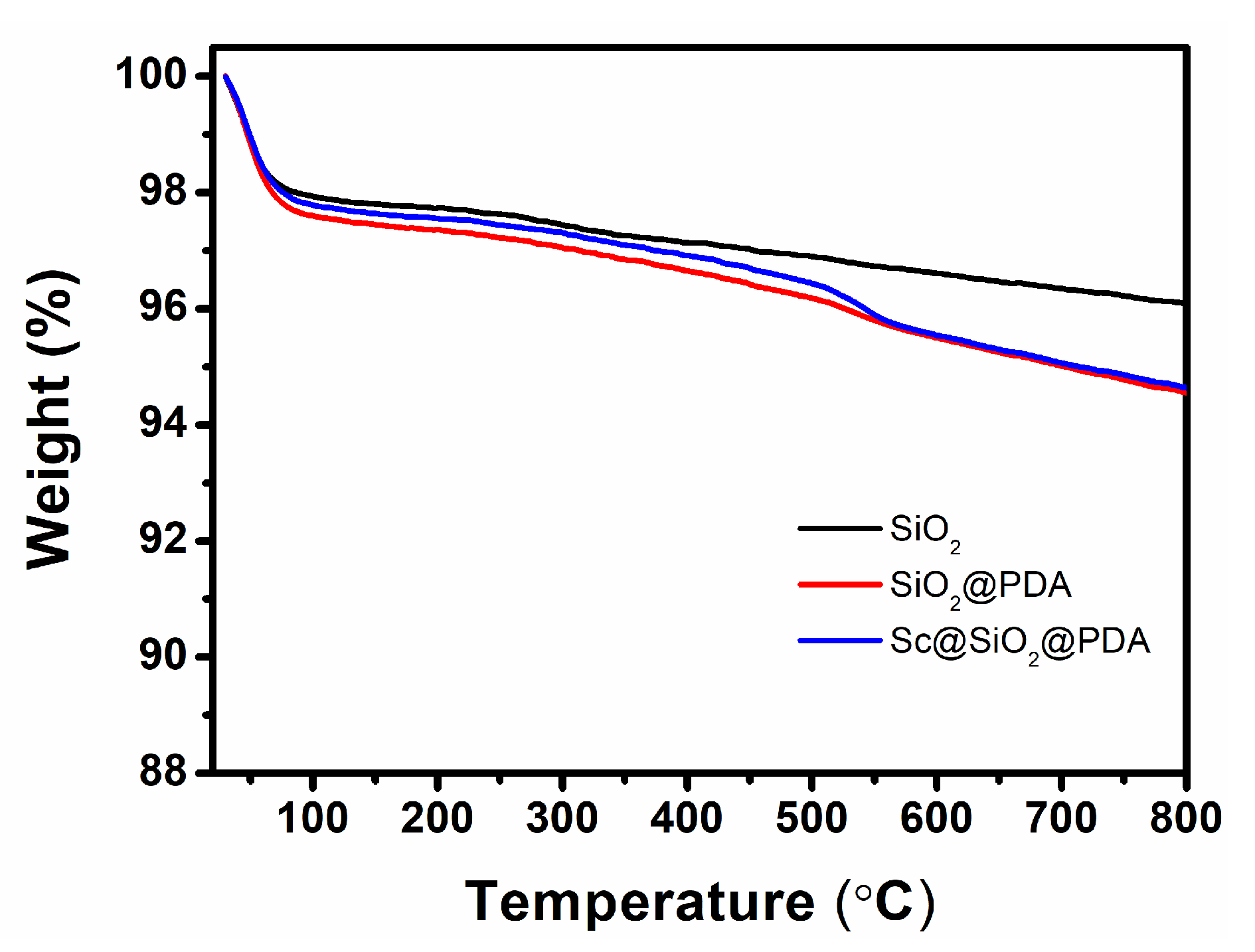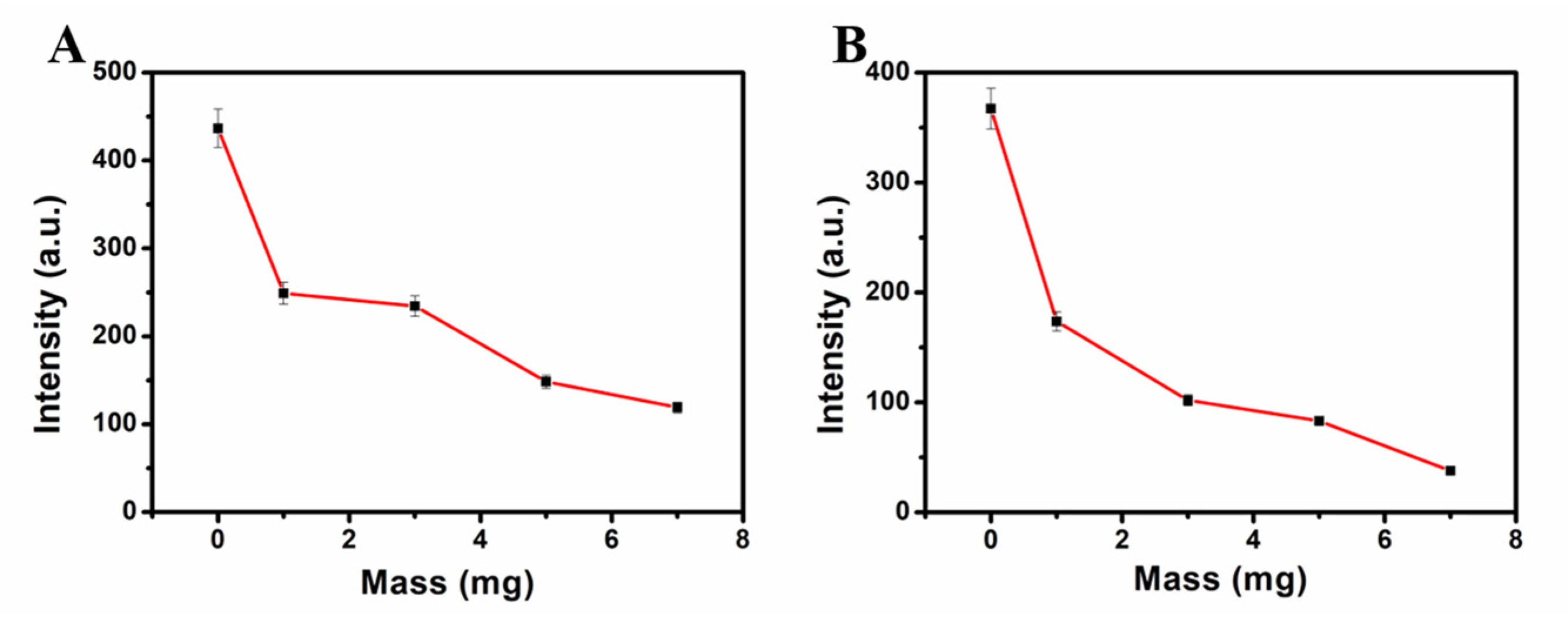Antifouling Performance and Sustained Release Behavior of Ethanol Extract from the Root of Stellera chamaejasme
Abstract
:1. Introduction
2. Materials and Methods
2.1. Materials
2.2. Methods
2.2.1. Preparation of Acrylic Resin Antifouling Coating
2.2.2. Preparation of Hollow Silica Spheres (SiO2)
2.2.3. Preparation of Silica Spheres @ Polydopamine (SiO2@PDA)
2.2.4. Sc@SiO2@PDA Microcapsules Sustained-Release Behavior
2.3. Testing and Characterization Methods
2.3.1. Characterization Instrument
2.3.2. Sc Standard Curve Drawing
2.3.3. Fluorescence Quenching Experiment of Sc and Sc@SiO2@PDA Microcapsules
2.3.4. Fluorescence Quenching Constant
2.3.5. Algae Adhesion Test
3. Results and Discussion
4. Conclusions
Author Contributions
Funding
Data Availability Statement
Acknowledgments
Conflicts of Interest
References
- Katharios-Lanwermeyer, S.; Xi, C.; Jakubovics, N.S.; Rickard, A.H. Mini-review: Microbial coaggregation: Ubiquity and implications for biofilm development. Biofouling 2014, 30, 1235–1251. [Google Scholar] [CrossRef] [PubMed]
- Hu, P.; Xie, Q.; Ma, C.; Zhang, G. Silicone-Based Fouling-Release Coatings for Marine Antifouling. Langmuir 2020, 36, 2170–2183. [Google Scholar] [CrossRef] [PubMed]
- Qian, P.-Y.; Li, Z.; Xu, Y.; Li, Y.; Fusetani, N. Mini-review: Marine natural products and their synthetic analogs as antifouling compounds: 2009–2014. Biofouling 2015, 31, 101–122. [Google Scholar] [CrossRef] [PubMed]
- Yang, W.; Lin, P.; Cheng, D.; Zhang, L.; Wu, Y.; Liu, Y.; Pei, X.; Zhou, F. Contribution of Charges in Polyvinyl Alcohol Networks to Marine Antifouling. ACS Appl. Mater. Inter. 2017, 9, 18295–18304. [Google Scholar] [CrossRef]
- Yoshikawa, C.; Takagi, R.; Nakaji-Hirabayashi, T.; Ochi, T.; Kawamura, Y.; Thissen, H. Marine Antifouling Coatings Based on Durable Bottlebrush Polymers. ACS Appl. Mater. Inter. 2022, 14, 32497–32509. [Google Scholar] [CrossRef]
- Wang, X.; Yang, J.; Jiang, X.; Yu, L. Preparation and Properties of Environmentally Friendly Marine Antifouling Coatings Based on a Collaborative Strategy. Langmuir 2022, 38, 6676–6689. [Google Scholar] [CrossRef]
- Jeong, Y.; Kang, S.M. Catechol-conjugated Dextran for Marine Antifouling Applications: The Adverse Effects of High Catechol Content. B. Korean Chem. Soc. 2020, 41, 1068–1072. [Google Scholar] [CrossRef]
- Evans, S.M. TBT or not TBT? That is the question. Biofouling 1999, 14, 117–129. [Google Scholar] [CrossRef]
- Xie, C.; Guo, H.; Zhao, W.; Zhang, L. Environmentally Friendly Marine Antifouling Coating Based on a Synergistic Strategy. Langmuir 2020, 36, 2396–2402. [Google Scholar] [CrossRef]
- Li, M.; Nan, L.; Zhang, B.; Kong, J.; Wang, Y.; Ba, M. Polyether-thiourea-siloxane copolymer based on H-bonding interaction for marine antifouling. Molecules 2023, 28, 3574. [Google Scholar] [CrossRef]
- Mohd-Ramzi, M.; Rahman, N.I.A.; Rawi, N.N.; Bhubalan, K.; Ariffin, F.; Mazlan, N.W.; Saidin, J.; Danish-Daniel, M.; Siong, J.Y.F.; Bakar, K. Antifouling potential of Diadema setosum and Sonneratia lanceolata extracts for marine applications. J. Mar. Sci. Eng. 2023, 11, 602. [Google Scholar] [CrossRef]
- Sun, L.; Wang, W.-F.; Li, M.; Zhang, J.; Chai, T.; Cao, W.; Yan, T.; Zhao, X.; Yang, W.; Yu, B.; et al. Natural Product Zanthoxylum bungeanum Based Multi-Functionalized Self-Polishing Interface for Sustainable Marine Antifouling. Adv. Mater. Inter. 2022, 9, 2201195. [Google Scholar] [CrossRef]
- Fusetani, N. Antifouling marine natural products. Nat. Prod. Rep. 2011, 28, 400–410. [Google Scholar] [CrossRef] [PubMed]
- Wang, K.-L.; Dou, Z.-R.; Gong, G.-F.; Li, H.-F.; Jiang, B.; Xu, Y. Anti-larval and anti-algal natural products from marine microorganisms as sources of anti-biofilm agents. Mar. Drugs 2022, 20, 90. [Google Scholar] [CrossRef] [PubMed]
- Sedanza, M.G.; Yoshida, A.; Kim, H.-J.; Yamaguchi, K.; Osatomi, K.; Satuito, C.G. Identification and Characterization of the Larval Settlement Pheromone Protein Components in Adult Shells of Crassostrea gigas: A Novel Function of Shell Matrix Proteins. Int. J. Mol. Sci. 2022, 23, 9816. [Google Scholar] [CrossRef]
- Umezawa, T.; Oguri, Y.; Matsuura, H.; Yamazaki, S.; Suzuki, M.; Yoshimura, E.; Furuta, T.; Nogata, Y.; Serisawa, Y.; Matsuyama-Serisawa, K.; et al. Omaezallene from Red Alga Laurencia sp.: Structure Elucidation, Total Synthesis, and Antifouling Activity. Angew. Chem. Int. Ed. 2014, 53, 3909–3912. [Google Scholar] [CrossRef]
- Kim, D.; Kang, S.M. Red Algae-Derived Carrageenan Coatings for Marine Antifouling Applications. Biomacromolecules 2020, 21, 5086–5092. [Google Scholar] [CrossRef]
- Davis, A.R.; Wright, A.E. Inhibition of larval settlement by natural products from the ascidian, Eudistoma olivaceum (Van Name). J. Chem. Ecol. 1990, 16, 1349–1357. [Google Scholar] [CrossRef]
- Gao, C.; Wang, Y.; Chen, Y.; He, B.; Zhang, R.; Xu, M.; Huang, R. Two new avermectin derivatives from the Beibu Gulf Gorgonian Anthogorgia Caerulea. Chem. Biodivers. 2014, 11, 812–818. [Google Scholar]
- Majik, M.S.; Rodrigues, C.; Mascarenhas, S.; D’Souza, L. Design and synthesis of marine natural product-based 1H-indole-2,3-dione scaffold as a new antifouling/antibacterial agent against fouling bacteria. Bioorg. Chem. 2014, 54, 89–95. [Google Scholar] [CrossRef]
- Cho, J.Y.; Kang, J.Y.; Hong, Y.K.; Baek, H.H.; Shin, H.W.; Kim, M.S. Isolation and structural determination of the antifouling diketopiperazines from marine-derived Streptomyces praecox 291-11. Biosci. Biotech. Bioch. 2012, 76, 1116–1121. [Google Scholar] [CrossRef]
- Nong, X.H.; Zheng, Z.H.; Zhang, X.Y.; Lu, X.H.; Qi, S.H. Polyketides from a marine-derived fungus Xylariaceae sp. Mar. Drugs 2013, 11, 1718–1727. [Google Scholar] [CrossRef] [PubMed]
- Lin, P.; Ding, L.; Lin, C.W.; Gu, F. Nonfouling property of zwitterionic cysteine surface. Langmuir 2014, 30, 6497–6507. [Google Scholar] [CrossRef] [PubMed]
- Peng, B.; Wang, J.; Peng, Z.; Zhou, S.; Wang, F.; Ji, Y.; Ye, Z.; Zhou, X.; Lin, T.; Zhang, X. Studies on the synthesis, pungency and anti-biofouling performance of capsaicin analogues. Sci. China Chem. 2011, 55, 435–442. [Google Scholar] [CrossRef]
- Liu, H.; Yang, W.; Zhao, W.; Zhang, J.; Cai, M.; Pei, X.; Zhou, F. Natural product inspired environmentally friendly strategy based on dopamine chemistry toward sustainable marine antifouling. ACS Omega 2020, 5, 21524–21530. [Google Scholar] [CrossRef]
- Zhang, Z.-Q.; Zhang, Y.-H.; Sun, H. The reproductive biology of Stellera chamaejasme (Thymelaeaceae): A self-incompatible weed with specialized flowers. Flora-Morphol. Distrib. Funct. Ecol. Plants 2011, 206, 567–574. [Google Scholar] [CrossRef]
- Weijian, F.; Tetsuro, I.; Mitsuzi, Y. The antitumor activities of gnidimacrin isolated from Stellera chamaejasme L. Chin. J. Cancer Res. 1996, 8, 101–104. [Google Scholar] [CrossRef]
- Yang, G.; Liao, Z.; Xu, Z.; Zhang, H.; Chen, D. Antimitotic and Antifungal C-3/C-3″-Biflavanones from Stellera chamaejasme. Chem. Pharm. Bull. 2005, 36, 776–779. [Google Scholar] [CrossRef]
- Cui, H.; Jin, H.; Liu, Q.; Yan, Z.; Ding, L.; Qin, B. Nematicidal metabolites from roots of Stellera chamaejasme against Bursaphelenchus xylophilus and Bursaphelenchus mucronatus. Pest. Manag. Sci. 2014, 70, 827–835. [Google Scholar] [CrossRef]
- Dehghan, H.; Sarrafi, Y.; Salehi, P.; Nejad- Ebrahimi, S. α-Glucosidase inhibitory and antioxidant activity of furanocoumarins from Heracleum persicum. Med. Chem. Res. 2017, 26, 849–855. [Google Scholar] [CrossRef]
- Deng, Z.; Chen, M.; Zhou, S.; You, B.; Wu, L. A novel method for the fabrication of monodisperse hollow silica spheres. Langmuir 2006, 22, 6403–6407. [Google Scholar] [CrossRef] [PubMed]
- Faÿ, F.; Champion, M.; Guennec, A.; Moppert, X.; Simon-Colin, C.; Elie, M. Biobased anti-adhesive marine coatings from polyhydroxyalkanoates and polysaccharides. Coatings 2023, 13, 766. [Google Scholar] [CrossRef]
- Jia, X.; Sheng, W.-B.; Li, W.; Tong, Y.-B.; Liu, Z.-Y.; Zhou, F. Adhesive polydopamine coated avermectin microcapsules for prolonging foliar pesticide retention. ACS Appl. Mater. Inter. 2014, 6, 19552–19558. [Google Scholar] [CrossRef] [PubMed]










Disclaimer/Publisher’s Note: The statements, opinions and data contained in all publications are solely those of the individual author(s) and contributor(s) and not of MDPI and/or the editor(s). MDPI and/or the editor(s) disclaim responsibility for any injury to people or property resulting from any ideas, methods, instructions or products referred to in the content. |
© 2023 by the authors. Licensee MDPI, Basel, Switzerland. This article is an open access article distributed under the terms and conditions of the Creative Commons Attribution (CC BY) license (https://creativecommons.org/licenses/by/4.0/).
Share and Cite
Zhao, W.; Li, F.; Chang, J.; Shang, Y.; Cao, Z.; Yang, W.; Zhou, F. Antifouling Performance and Sustained Release Behavior of Ethanol Extract from the Root of Stellera chamaejasme. Crystals 2023, 13, 798. https://doi.org/10.3390/cryst13050798
Zhao W, Li F, Chang J, Shang Y, Cao Z, Yang W, Zhou F. Antifouling Performance and Sustained Release Behavior of Ethanol Extract from the Root of Stellera chamaejasme. Crystals. 2023; 13(5):798. https://doi.org/10.3390/cryst13050798
Chicago/Turabian StyleZhao, Wenwen, Feixiang Li, Jianxiu Chang, Yu Shang, Zhongyue Cao, Wufang Yang, and Feng Zhou. 2023. "Antifouling Performance and Sustained Release Behavior of Ethanol Extract from the Root of Stellera chamaejasme" Crystals 13, no. 5: 798. https://doi.org/10.3390/cryst13050798






